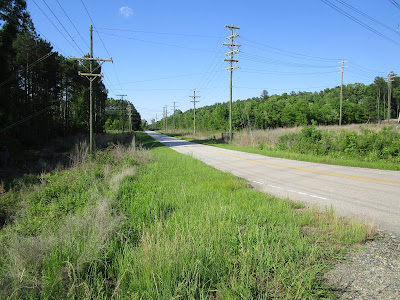 |
| The first and largest South Alston pinxterflower azalea starting to bloom in late April a few years ago ©. |
Pinxterflowers (Rhododendron
periclymenoides), also called pink azaleas, are deciduous azaleas
that have pale reddish purple or pink flowers with some fragrance in
late April and are found in the East from New York and Vermont to
Illinois and Alabama. Several deciduous azaleas and larger evergreen
rhododendrons are native to North Carolina, but grow mostly west and
east of the Triangle, while the ornamental evergreen azaleas common
in landscaping come from East Asia (pinxterflowers and other natives
are sometimes planted, for example there are some native flame
azaleas at UNC, but Asian azaleas are far more common). Long ago I
noticed a large pinxterflower growing near South Alston Road in
southern Durham County, between TW Alexander Drive and Highway 55,
just outside of Research Triangle Park. It grew beside a tiny brook
that trickles over outcroppings of igneous rock in a wooded area that
must have been a farm not many decades ago. Despite the tiny size of
the brook, it has basically permanent pools and supports a breeding
population of surprisingly large sunfish, as well as numerous
crayfish (perhaps attracting queen snakes, which specialize in eating
these crustaceans), black damselflies, and other invertebrates.
Years ago, if not now, salamander species bred there, but conditions
might have changed too much for them now. On the other side of the
road an old tobacco barn stood next to a railroad paralleling Alston.
There were other flowers in the woodland glade, such as very rare
crimson red firepinks (I only know of two areas were they grow
naturally, both in Durham), flowering spurge, yellow trout lilies,
arrowwood, and painted buckeyes.
That was a few decades ago, and there
have been many changes since then, endangering the pinxterflowers and
other rare plants, now more widely known among locals. One of the
highest hills around, with a commanding view up and down Highway 55,
where the farm house was, was blasted away day and night around 10
years ago in early summer (leading to noise complaints to the police
from several miles away, on Scott King Road). A County official said
that the rock and soil was sold as fill to build the first toll road
in North Carolina a few miles east down Hopson Road, and the rest was
dumped in the nearby Triangle Brick Company claypit. There were
plans for something like apartments or a strip mall on the plain left
after the hill was demolished, across from the Triangle Wastewater
Treatment Plant, but those fell through. Around two years ago Durham
County bought the site for a sludge drying facility, but there are
still plans for a residential project on the other (northeast) corner
of 55 and TW Alexander Drive, just north. Around the time when the
hill was destroyed, South Alston was split and renamed at a railroad
crossing (also a copperhead crossing in late September and another
place where firepinks grew in the vicinity), creating Solutions Drive
to the north and Experiment Drive to the south. Part of nearby
Hopson Road became part of new north-south running Louis Stephens
Drive, connecting it to TW Alexander and another ridge, from which
UNC Hospital can be seen several miles west, though it is more an
issue of lack of trees than elevation, was cut through to connect
Hopson Road directly to Highway 55. Hopson and Alston have been
moved around a few times in this area.
The main threat is Duke Energy, but the
situation is complicated by Federal security contractors working for
the Social Security Administration who have appropriated public roads
near the pinxterflowers and far from the Federal facility. The SSA's
unmarked Second Security Facility, which apparently prints social
security cards, is the large building behind a black fence near the
corner of Solutions Drive and Louis Stephens Drive (address 3604
Louis Stephens Drive; a search for this address plus social security
administration reveals a lot of information), next to the older
JMCUSA factory further south. The SSA's security contractors patrol
Solutions Drive and Experiment Drive, telling people that they can't
use these public roads, and they also drive on nearby roads, though
it is an open question whether they would harass someone stopped
there ( see
www.fedconnect.net/FedConnect/PublicPages/PublicSearch/Public_OpportunityDescription.aspx?id=34504
and govtribe.com/opportunity/federal-contract-opportunity/armed-guard-services-at-the-second-support-center-in-durham-nc-ssarfp141008
). Looking more carefully at the sign for Experiment Drive, it
doesn't say this is a state-maintained road, but it isn't marked private either
(and someone mows the shoulders) and it began as one of the oldest public roads in the area. The
azaleas are around a fourth of a mile from the SSA's property and it
cannot be seen from that end of the road. The contractors regularly
patrol in SUVs, and they might have surveillance equipment on land
they don't own (but they seem to surveill the former railroad
crossing with their parking lot security cameras, though they can't
see the rest of the tracks). The situation seems to have gotten
worse over the years and while the contractors, who it is said are
heavily armed, shouldn't have police power outside of the SSA's
facility and as far as I know they don't get out of their vehicle and
follow people away from the road, they are intimidating and they
could involve the Durham police or Sheriff's deputies, and I expect
that the police would side with the SSA and corporations in a
dispute. There are similar situations elsewhere in and around RTP
where corporations claim more than they have title to. People used
to fish at a pond north of the substation, but were presumably driven
off, and it seems that immigrants were living in the tobacco barn
before it burned down. I don't know the circumstances, except that
they seemed to have beat a hasty retreat. The Social Security
Administration might have lobbied for the changes in this part of the
old South Alston corridor, and the City of Durham has paid a few
thousand dollars for construction and renovations at the SSA's
facility over the years (see homeflock.com/contractor/10812784 ).
Complaints have been made, though the City and County don't have
answers and Congressman David Price's office says go to the General
Assembly, which seems to be their default way of answering without
answering. One solution is to talk about the situation and for
people to go there and make the SSA expend time and money for what it
wants to seize from the public. Duke Energy is being lobbied, and a
long-term solution is to change herbicide regulations at the State or
Federal level.
 |
| An SSA security contractor Jeep on Experiment Drive; this photo is from a few years ago, so the vehicles look different now ©. |
As I worked on this article, a related
problem arose. There is a group of pinxterflowers near Crooked Creek
on Scott King Road, a few miles west of the above site, on land
protected as part of the gamelands around Jordan Lake (owned by the
US Army Corps of Engineers and leased to the NC Wildlife Commission).
In July someone sprayed an herbicide on both sides of the road
(including up into surrounding canopy trees) and under a nearby
distribution powerline for roughly one and a half miles along Scott
King Road, injuring the pinxterflowers, but they seem to have
survived. At first it seemed like saplings along the road were
drought-stressed and changing color and dropping their leaves early,
but it became clear that they had been sprayed with something. This
general spraying did not seem like Duke Energy's work, though they
are spraying under the long-distance transmission line nearby, the
same line that crosses Experiment Drive and their contractor Asplundh
is cutting trees along powerlines in nearby residential areas. About
a year ago Duke Energy's distribution line maintenance department cut
a pretty old red oak, probably a Spanish/southern red oak, growing
under a small powerline nearby, at the corner of Fayetteville Road
and NC 751, in front of an abandoned house, since no one was living
there to stop them. Sometimes an objection is all it takes to save
part of the landscape. That tree used to be a landmark on the way
south to Jordan Lake. There are PSNC Energy natural gas pipelines
along Scott King Road, but a representative says they only mow their
right of ways. There is a fiber optic cable, with MCI signs, but
probably owned by a different company now (such as Frontier
Communications), and I thought they were the culprit, but the NC DOT
admitted to doing the spraying. They also sprayed in several places,
mostly at creek crossings, along Highway 54 to the outskirts of
Chapel Hill, using Garlon 3A (Triclopyr) and RRSI NIS surfactant,
which apparently kills only branches it directly hits. The DOT says
the spraying was done over “sight distance issues” and that
vegetation problems can return in less than a year after mowing,
while using both mechanical cutting and herbicide can control
vegetation for three years. They spent almost $30 million dollars
statewide from July into August on mechanical cutting, and $2.75
million on herbicide. Many of the places sprayed, including along
Scott King Road, are straight and vegetation is not interfering with
traffic, while the narrow, uneven shoulders and lack of guardrails at
drop offs are much more dangerous. The only potential benefit is that
the non-native kudzu surging over the guardrails at Little Creek near
Chapel Hill was sprayed, but I'm sure it will be back again next
summer. The pinxterflowers are within the 30-foot easement DOT
claims on each side of Scott King, so their spraying is probably
legal, but the pinxterflowers are at the edge of the protected
forest, not within reach of the roadside shoulder, so there was no
benefit to the DOT in spraying them. Simply spraying herbicide on
everything to maintain a right of way is a wretchedly cheap and
indiscriminate, as well as ugly way to maintain an easement (on
roadsides often already well littered, revealed even more after the
vegetation is dead). Everything was sprayed, from large sweetgum and
loblolly pine saplings and the lower limbs of tall trees, to a small
winged elm sapling along a fence under a powerline by the American
Tobacco Trail, down to sensitive ferns and a clump of goldenrods
about to bloom between two yards, as if in spite, and other
wildflowers. Of course, not every plant was doused enough to be
killed, and it seems like the groundsel bushes have such thick, waxy
leaves that they can resist herbicide, but they are relatively
common. Possibly the sourwoods also have some degree of resistance.
I am thinking about what can be done, but changing national or state
herbicide regulations could also prevent the DOT's wanton spraying.
[As of fall 2019 the pinxterflowers along Scott King Road survived the DOT's spraying, but were damaged and probably did not flower that year. Whether any still grow at the site near RTP is unknown.]
[As of fall 2019 the pinxterflowers along Scott King Road survived the DOT's spraying, but were damaged and probably did not flower that year. Whether any still grow at the site near RTP is unknown.]
 |
| A pinxterflower on Scott King Road blooming last April; the peak blooming has passed and the bush is leafing out ©. |
 |
| Oak cut by Duke Energy at the corner of NC 751 (shown) and Fayetteville Road; its limbs and trunk are on the right ©. |









